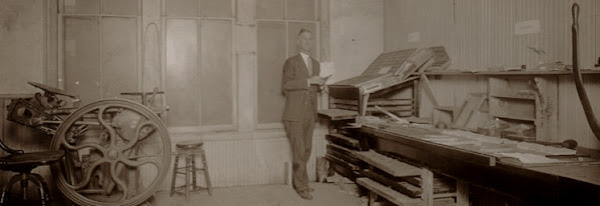I made my own press modeling it on a style once commonly available from most printing supply houses and still available in one form or another, even on Ebay. The biggest difference is that I made mine from scrap lumber and plywood and it cost me nothing but time and a couple bucks for the two pieces of chain and the screw hooks.
The press consists of a base, a removable vertical backboard, a bottom board and a top board. You can see most of these parts in the photo. The photo is from last year and shows my original pads. To use it you stand the backboard on the base and lay the bottom board on the base. After first folding the edge of a sheet of index and laying it on the bottom board, you take a stack or stacks of pads (whatever will fit depending on the size of the press or pads) and place them on the bottom board with the top of the pads against the backboard. The pads of course have already been made up by interspersing a piece of chipboard alternately between the number of sheets each pad will have. You jog the stack so it is nice and square and the sheets are even all around. Then another sheet of index is folded and laid on top of the pads after which the top board is put on, the chains connected to the screw hooks, and the wing nuts tightened to squeeze the stack of pads. How much they should be squeezed depends on how tall the stack is but there's a lot of "that seems about right" involved.
The top and bottom boards with the pads in between can then be lifted up as one unit and turned around on the base so that the tops of the stacked pads are facing you. The sheets of index can be folded up and down out of the way. They are there to prevent padding cement from getting all over the boards.
As might be expected from the name, padding cement is a special adhesive used for pads. It is sort of rubber-like when it dries and I'm sure everyone has used a pad at one time or another and so is at least familiar with it in a user's sense. It can be purchased from printer's supply houses, art suppliers, etc. It's available in a few colors though white seems to be the most common. The cement I have is water-based and I just take a cheap brush and paint on the cement making sure to work it in well so I don't miss any spots. I let it dry and then put on a second coat. Most people probably use just one coat but I like two for strength. Another way to strengthen the top is to press cheesecloth over the first coat while it is wet and then paint on a second coat.
In a pinch, the pads can be stacked on the edge of a table and a brick or two laid on top to prepare for the cement. This is the method given in an older graphic arts textbook I have. But I like the surety and stability of the press.
Once the cement is completely dry (I leave it overnight) I cut the pads apart with a wide-bladed knife. There's a bit of a technique to this which is easily learned by doing it a few times and after which you can slice them up like butta.
Pads are easy, cheap, and a great project and always seem to be a big hit with everyone I give them to. Obviously they can also be used in business-like ways for advertising, etc. I would only add that you need a lot of sheets to make them. I printed almost 600 sheets on my last pad project which yielded 17 pads of about 35 sheets each. So you Vandercook users may want to pay a visit to your friend's motorized platen press. Heidelburg owners are in luck.




3 comments:
Rich,
Thanks for the explanation! I've actually got a press that I use for drying handmade paper, which seems like it could do the job. Now I'll just have to look for some of that padding cement...
:)
Nina
Hi Rich, I know you and I have have discussed notepads before, but I want to agree again how great and crowd-pleasing making these pads is.
I use my regular book press to make mine, but I should really pick up some padding cement. I've been getting by with multiple coats of PVA, but it sounds like cement would be better.
I'm confused about how the chains fit in to your set up, but I'll read it again and probably understand.
When are we going to see pictures of your submission for the letterpress print swap you did?
-Maggie
Ah yes, the swap! I forgot to make that post even though I scanned the sheet. But first I'll make a short post explaining the hooks and chain which I should have added to begin with.
Post a Comment